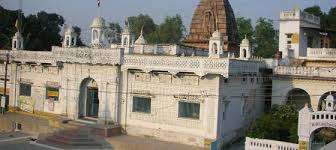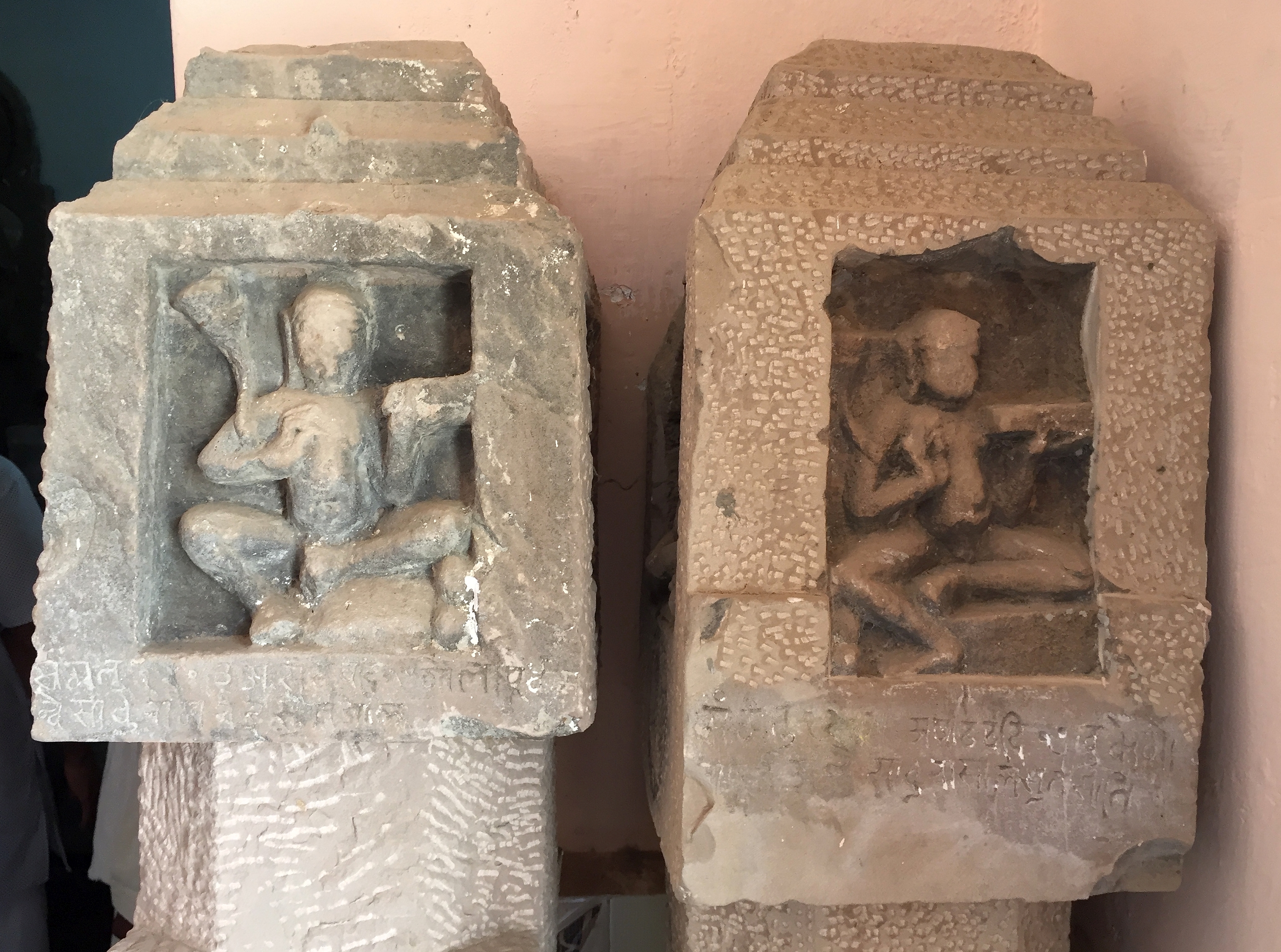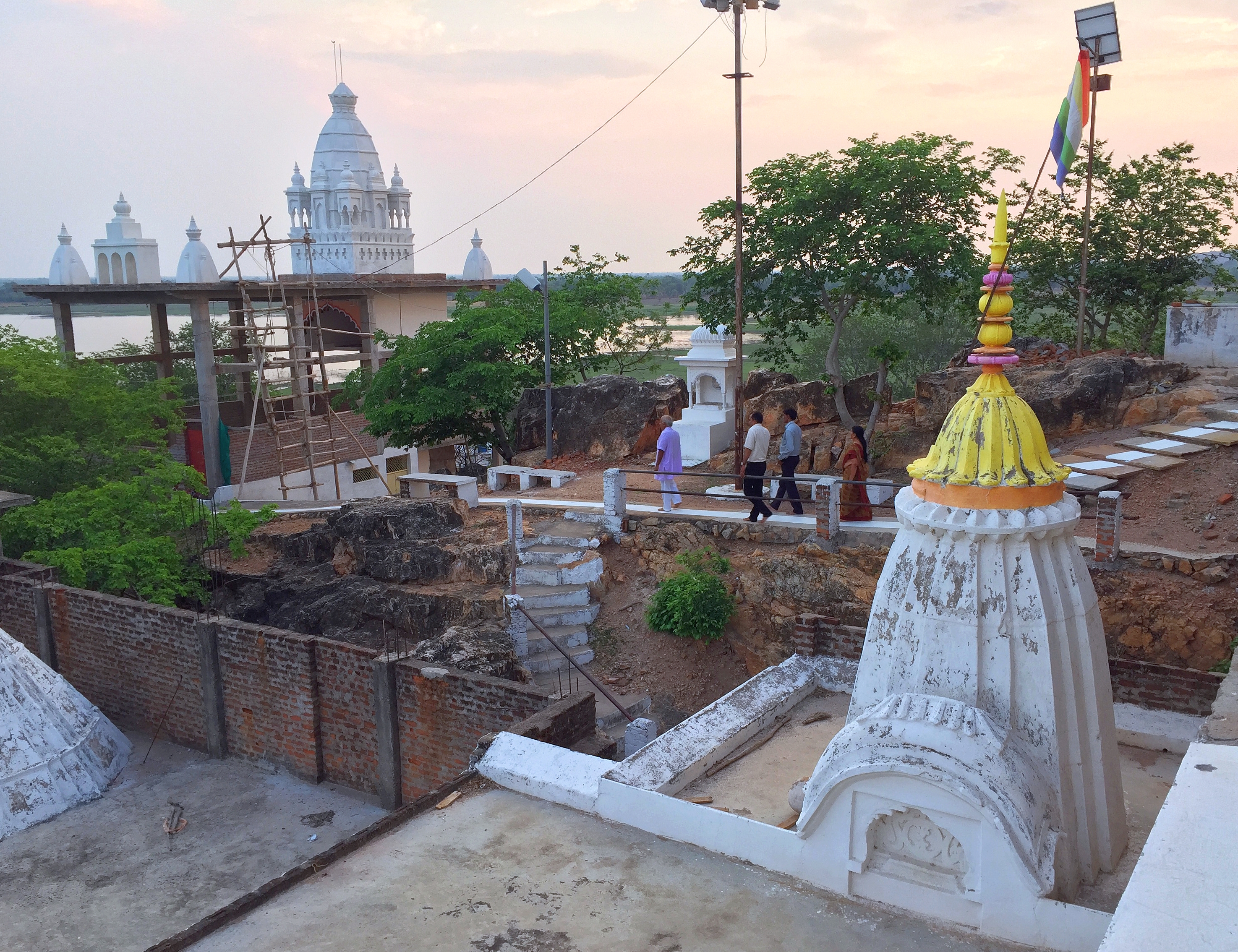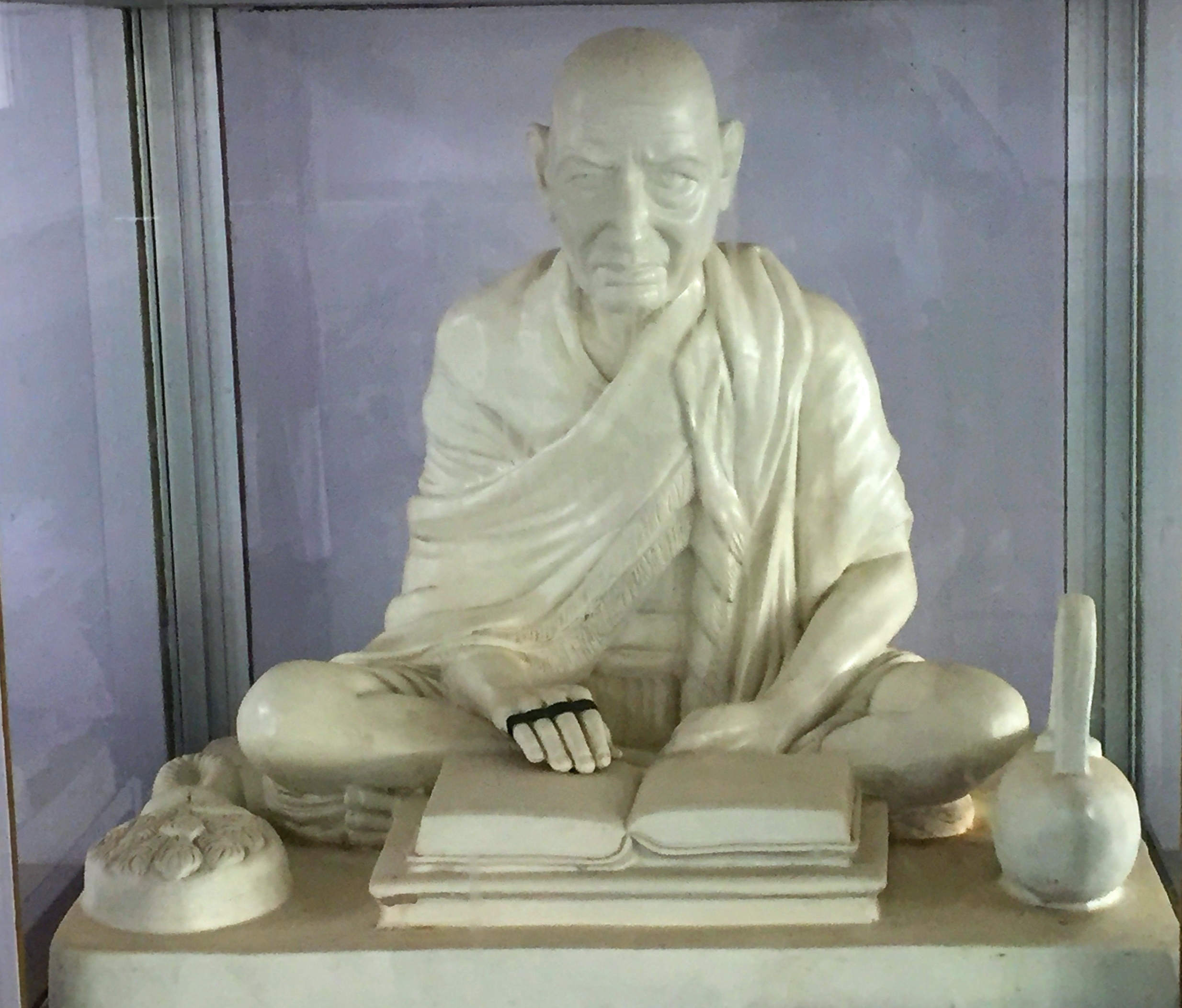|
Paporaji
Paporaji, also called Pampapur, a temple site in Madhya Pradesh, India, 5 km east of Tikamgarh. The site is a center for the Jainism, Jain religion. This is an atishaya kshetra ("miraculous holy place"), with 108 shrines. History Poporaji is more than eight hundred years old. The site has two basements; one of them has three idols. The idol of Bhagwan Adinath is made of shining black stone and is two feet and eight inches in height. Idols inside are also in same color and stone. Two of the three Adinath idols were installed in V.S. 1202 (AD 1145) according to the inscriptions on them and are oldest at this Kshetra. In 1783, the ruler of Orchha Vikramajit (1776–1817) shifted his capital from Orchha to Tehri and renamed it Tikamgarh, which is in the vicinity of Papora. An inscription of Vikrama 1840 (AD 1784) suggests that the site then had emerged as a tirtha. Motilal Varni (an associate of Ganesh Varni), had established a religious school which has produced several dis ... [...More Info...] [...Related Items...] OR: [Wikipedia] [Google] [Baidu] |
Tikamgarh
Tikamgarh is a Census town#India, town and a tehsil in Tikamgarh district in the Indian state of Madhya Pradesh. The city serves as a district headquarters. The earlier name of Tikamgarh was Tehri (i.e., a triangle) consisting of three hamlets, forming a rough triangle. In Tikamgarh town there is locality still known as 'Purani Tehri' (Old Tehri). Until Indian independence in 1947, Tikamgarh, formerly called Tehri, was part of the kingdom of Orchha, which was founded in the 16th century by the Bundeli chief Rudra Pratap Singh, who became the first King of Orchha. In 1783 the capital of the state was moved to Tehri, about south of Orchha, which was home to the fort of Tikamgarh, and the town eventually took the name of the fort. The district is famous for the old fort of Kundar known as Garh Kundar, which was built by Khangars and remained the capital of Khangar rulers from 1180 to 1347. Origin of the name The district is named after its headquarter, Tikamgarh. The original na ... [...More Info...] [...Related Items...] OR: [Wikipedia] [Google] [Baidu] |
Bandhaji
Bandhaji is a historic Jain tirtha about 35 km from Tikamgarh. History The 900 year old black colored idol of principal deity Bhagwan Ajitnatha is installed in a basement of Shri Bandhaji Atishaya Kshetra. According to historical and archeological evidence available this Kshetra seems to be more than 1,500 years old. The seven Bhonyare (Basements) are quite famous in ‘Bundelkhand’. They are situated in ‘Pava’, ‘Deogarh’, ‘Seron’, ‘Karguvan’, ‘Bandha’, ‘Papora’ and ‘Thuvon’. It is said that these seven Basements were constructed by two brothers namely Devpat and Khevpat. The two ancient spired temples are also constructed here which are worth seeing from the point of view of art and magnificence.Bharat Ke Digambar Jain Tirth, Pt. 3, Balbhadra Jain, Bharatvarshiya Digambar Jain Tirthkshetra Committee, Bharatiya Janapitha, 1976, p. 107 This Kshetra is quite wealthy from the point of view of archeology. The important matter related to Jainism i ... [...More Info...] [...Related Items...] OR: [Wikipedia] [Google] [Baidu] |
Rishabhanatha
Rishabhanatha, also ( sa, ऋषभदेव), Rishabhadeva, or Ikshvaku is the first (Supreme preacher) of Jainism and establisher of Ikshvaku dynasty. He was the first of twenty-four teachers in the present half-cycle of time in Jain cosmology, and called a "ford maker" because his teachings helped one across the sea of interminable rebirths and deaths. The legends depict him as having lived millions of years ago. He was the spiritual successor of Sampratti Bhagwan, the last Tirthankar of previous time cycle. He is also known as Ādinātha which translates into "First (''Adi'') Lord (''nātha'')", as well as Adishvara (first Jina), Yugadideva (first deva of the yuga), Prathamarajeshwara (first God-king), Ikshvaku and Nabheya (son of Nabhi). Along with Mahavira, Parshvanath, Neminath, and Shantinath; Rishabhanath is one of the five Tirthankaras that attract the most devotional worship among the Jains. According to traditional accounts, he was born to king Nabhi and q ... [...More Info...] [...Related Items...] OR: [Wikipedia] [Google] [Baidu] |
Navagarh
Navagarh is a Jain Tirth (pilgrimage site for Jainism) in India. It is located at the Nabai village near Sojna in central India in Uttar Pradesh, just across the border from Madhya Pradesh. It is 65 km east from Lalitpur and 110 km north from Sagar. This ancient cite was excavated in 1959. It is the only tirth in India where the main deity is the ancient image of Lord Aranatha, preserved in the ancient underground chamber. Navagarh Tirth Navagarh is a place full of natural attractive beauty being surrounded by rocky wilderness. It is famous for the exceptionally crafted life size image of Lord (Aranatha) in standing (Kayotsarga) posture. It is in the Chandela style and finely polished. It does not have an inscription, but a fragment of a Shantinatha image from the same chamber has the date samvat 1202. There are nearby prehistoric rock shelters where Jain monks used to meditate. Some of them contain prehistoric drawings. Discovery and development In 1940s the site ... [...More Info...] [...Related Items...] OR: [Wikipedia] [Google] [Baidu] |
Bhoyras
Three historical idols of Lord Adinath belonging to 1145(VS 1202) in the underground chamber at Paporaji In Jainism, a Bhonyra ( pra, भोंयरा , sa, भूमिगृह ) is an underground chamber with Jain images. In the past, it was used to conceal sacred idols during times of disturbance. There are several Jain temples in Bundelkhand that existed as a concealed bhonyra chamber for several centuries before being rediscovered. In 2001, an entire Jain temple was found beneath a mound known as Rajgadhi Timbo at Umta, Gujarat. It was apparently buried to protect it from the destruction about 800 years ago. In some regions, it became a common practice to build a bhonyra attached to the temple. Naya Mandir in Delhi has a concealed chamber. A visitor in 1876 described it:In Delhi I found a Jain temple which was wholly unknown to Europeans well acquainted with the city; and on prosecuting inquiry, I got its priest to open to me a concealed chamber containing large ... [...More Info...] [...Related Items...] OR: [Wikipedia] [Google] [Baidu] |
Jainism
Jainism ( ), also known as Jain Dharma, is an Indian religions, Indian religion. Jainism traces its spiritual ideas and history through the succession of twenty-four tirthankaras (supreme preachers of ''Dharma''), with the first in the current time cycle being Rishabhadeva, whom the tradition holds to have lived millions of years ago, the twenty-third ''tirthankara'' Parshvanatha, whom historians date to the 9th century BCE, and the twenty-fourth ''tirthankara'' Mahāvīra, Mahavira, around 600 BCE. Jainism is considered to be an eternal ''dharma'' with the ''tirthankaras'' guiding every time cycle of the Jain cosmology, cosmology. The three main pillars of Jainism are ''Ahimsa in Jainism, ahiṃsā'' (non-violence), ''anekāntavāda'' (non-absolutism), and ''aparigraha'' (asceticism). Jain monks, after positioning themselves in the sublime state of soul consciousness, take five main vows: ''ahiṃsā'' (non-violence), ''satya'' (truth), ''Achourya, asteya'' (not stealing), ''b ... [...More Info...] [...Related Items...] OR: [Wikipedia] [Google] [Baidu] |
Jain Temples In Madhya Pradesh
Jainism ( ), also known as Jain Dharma, is an Indian religion. Jainism traces its spiritual ideas and history through the succession of twenty-four tirthankaras (supreme preachers of ''Dharma''), with the first in the current time cycle being Rishabhadeva, whom the tradition holds to have lived millions of years ago, the twenty-third ''tirthankara'' Parshvanatha, whom historians date to the 9th century BCE, and the twenty-fourth ''tirthankara'' Mahavira, around 600 BCE. Jainism is considered to be an eternal ''dharma'' with the ''tirthankaras'' guiding every time cycle of the cosmology. The three main pillars of Jainism are ''ahiṃsā'' (non-violence), ''anekāntavāda'' (non-absolutism), and ''aparigraha'' (asceticism). Jain monks, after positioning themselves in the sublime state of soul consciousness, take five main vows: ''ahiṃsā'' (non-violence), ''satya'' (truth), ''asteya'' (not stealing), ''brahmacharya'' (chastity), and ''aparigraha'' (non-possessiveness). These pr ... [...More Info...] [...Related Items...] OR: [Wikipedia] [Google] [Baidu] |
Badagaon
Badagaon Dhasan is a town and a Nagar Parishad (City Council) in Tikamgarh district in the state of Madhya Pradesh, India. Demographics India census, Badagaon had a population of 18,584. Males constitute 52% of the population and females 48%. Badagaon has a literacy rate of 84%, much higher than the national average of 65%, with 89% of the males and 71% of females literate. 60% of the population is under 25 years of age. Education Most primary and secondary schools in Badagaon are affiliated with the state level M.P. Board. Among the main schools are: * Amar Shaheed Narayan Das Khare Government Higher Secondary School * Government Girls High School * Government Primary School * Mata Beti Bai Higher secondary School * Vardhaman val vidhya niketan higher secondary school *Kids Care Convent School *Manshapurna public high school Badagaon is also famous for its highly educated people who have made it to civil services and top positions in different sectors. The intellect and guts ... [...More Info...] [...Related Items...] OR: [Wikipedia] [Google] [Baidu] |
Nainagiri
Nainagiri is a major pilgrimage site for Jainism in India. It is located in the central Indian state of Madhya Pradesh, it is 12 km from Dalpatpur and 25 km from Bukswaha. This tirth, also known as Reshandigiri, is a Siddha Kshetra where five ancient saints including Varadatta had attained nirvana. Significance According to ancient Nirvanakanda text: पासस्स समवसरणे सहिया वरदत्त मुणिवरा पंच , रिस्सिन्देगिरि सिहरे णिव्वाण गया णमो तेसिं , , Translation: Here at Resandigiri, the samosharana of Lord Parshvanath had come and Varadatta etc. five munis had attained nirvana. We bow to them. Similar mentions are made in Hindi Nirvanakanda (1684 AD) of Bhaiya Bhagavatidas, and 1882 marathi text of Bhattaraka Devendrakirti of Karanja. Nainagiri Jain Tirtha Complex Naingiri Tirthkshetra includes a temple complex on the hill, two ... [...More Info...] [...Related Items...] OR: [Wikipedia] [Google] [Baidu] |
Aharji
Aharji is a historical pilgrimage site for Jainism in India. It is located in the central Indian state of Madhya Pradesh, on the road from Tikamgarh to Chhatarpur. This place is famous for Jain Temple. Aharji Jain Teerth Aharji is a place full of natural attractive beauty. It is famous for the miraculous colossus of Lord (Shantinath) in standing (Khadagasana) posture. It is 18 feet in height. The main temple is famous for beautiful monumental image of Lord Shatinath from the Chandella period. It has an inscription on it of 1180 AD (Vikram Samvat 1237). It was the last major temple to be built here in the Chandella period. Several other smaller temples were built here at the same time as the main temple. Excavations have found a large number of Jain images that were installed here during 954 to 1275 AD (Samvat 1011 to Samvat 1332), spanning the reigns of six Chandella rulers. This was a major Jain center during the Chandella period. The inscriptions give the names of 32 separa ... [...More Info...] [...Related Items...] OR: [Wikipedia] [Google] [Baidu] |
Ganesh Varni
Ganesha ( sa, गणेश, ), also known as Ganapati, Vinayaka, and Pillaiyar, is one of the best-known and most worshipped deities in the Hindu pantheon and is the Supreme God in Ganapatya sect. His image is found throughout India. Hindu denominations worship him regardless of affiliations. Devotion to Ganesha is widely diffused and extends to Jains and Buddhists and includes Nepal, Sri Lanka, Thailand, Indonesia (Java and Bali), Singapore, Malaysia, Philippines, and Bangladesh and in countries with large ethnic Indian populations including Fiji, Guyana, Mauritius, and Trinidad and Tobago. Although Ganesha has many attributes, he is readily identified by his elephant head. He is widely revered, more specifically, as the remover of obstacles and thought to bring good luck; the patron of arts and sciences; and the deva of intellect and wisdom. As the god of beginnings, he is honoured at the start of rites and ceremonies. Ganesha is also invoked as a patron of letters and lea ... [...More Info...] [...Related Items...] OR: [Wikipedia] [Google] [Baidu] |
Orchha
Orchha is a town, near city of Niwari in Niwari district of Madhya Pradesh state, India. The town was established by rajput ruler Rudra Pratap Singh some time after 1501, as the seat of an eponymous former princely state of covering parts of central & north India, in the Bundelkhand region. Orchha lies on the Betwa River, 80 km from Tikamgarh & 15 km from Jhansi in Uttar Pradesh. It is included in the UNESCO world heritage cities list in 2020. History Orchha was founded in 1531 (the 16th century AD) by the Bundela chief, Rudra Pratap Singh, who became the first King of Orchha, (r. 1501–1531) and also built the Fort of Orchha. The Chaturbhuj Temple was built by the queen of Orchha, Ganesh Kunwar (गणेश कुँवर), while ''Raj Mandir'' was built by 'Raja Madhukar Shah' during his reign, 1554 to 1591. Orchha was captured by imperial forces of the Mughal Army led by Prince Aurangzeb in October 1635. File:Ram Raja Temple, Orchha, Madhya Pradesh, Indi ... [...More Info...] [...Related Items...] OR: [Wikipedia] [Google] [Baidu] |







.jpg)